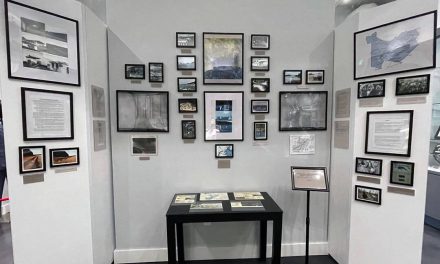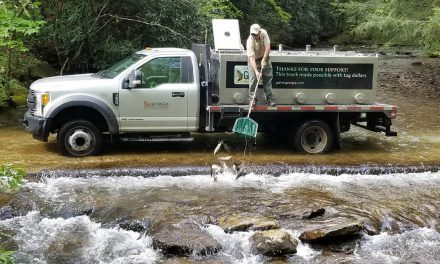In January, Lakeside News’ senior reporter traveled to Morocco. Overlooking the Mediterranean Sea and the Atlantic Ocean, it’s bisected by the Atlas Mountains, bordered by Algeria on the east and shares the Sahara Desert with more than a half-dozen African countries.
Known by most Americans as the setting for the movie “Casablanca,” the country’s intrigue and mystery would unfold as we dug deep into this amazing culture. Part one of two.
Landing at the airport in Casablanca made me more than curious: Where was Rick and his famous café, and what part of the airport was used to film the famous movie? Would we have a chance to visit the notorious Rick’s Café? Surely the Moroccans had created a tribute to the movie that won eight Oscars?
Most people know the film “Casablanca,” the 1942 exotic romance starring Humphrey Bogart and Ingrid Bergman. Not to disappoint you, but first, none of the movie was filmed in Morocco, not even the iconic scene at the airport. Second, there is no real Rick’s Café. The film was all Hollywood and not a single Moroccan participated in the filming.
Our search for Bogart and Bergman didn’t last long. Our attention turned to the many adventures that we’d discover in the next 18 days – sleeping in tents in the Sahara, riding camels across the endless dunes, exploring the ancient medinas, staying in elegant riads and meeting nomads.
Our driver met us at the airport to take us to Rabat, the capital of the country. Near the city, the 55-story Mohammed VI Tower pierced the skyline in the midst of modern architecture, office buildings, world-class hotels and excellent roads. However, we didn’t stop in the modern city; our destination was the medina of Rabat, the walled city of the ancient town, some parts as old as the Middle Ages.

Abdu, our trip leader
Meeting us at the edge of the old city, Abdu, our trip leader, guided us through the narrow, winding and crowded streets to our first riad where we would stay for two nights.
A large bronze door on a very narrow street opened to an amazing discovery: don’t make quick judgments. As we walked past the reception desk, the space opened onto an interior courtyard where our rooms awaited. A massive 14-foot door of elaborate woodwork opened in sections of varying heights into our sleeping room. Off to one side the spacious bathroom featured a sunken tub.
Most tourists stay in modern hotels when they travel to Morocco, but Overseas Adventure Travel’s “We’re not tourists, we’re travelers” bears out the company’s approach to immersive exploration. From trip experience leaders who have grown up in the countries we explore to ultra-local guides in many towns that delve even further in depth, I thrive on the “beyond the obvious” I’ve found with OAT and its sister company, Grand Circle Tours.
Riads are traditional Moroccan houses or palaces built around a courtyard with private guest rooms and baths. Sometimes a riad comprises several large houses that may be connected by passageways. The elaborate public areas’ décor includes 15- to 20-foot multi-level ceilings with intricately carved wood, corbels and plaster molding. The ornamentation is almost overwhelming.
Moroccan customs
During our journey, our accommodations included several riads, a permanent Sahara tented camp in the Sahara and a five-star modern hotel. Each experience took us deeper into the culture and history of Morocco.
Our first introduction to Moroccan customs? Our hosts served us hot Moroccan mint tea, poured into small glass tumblers from a footed silver-plated brass teapot. It was to be the beverage of the trip, either sweetened with a sugar cube or unsweetened.
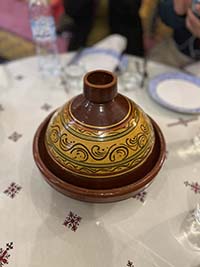
Tajines are domed pottery vessels, typically used to slow-cook vegetables and meats. It is the National dish.
We quickly became acquainted with Morocco’s national dish – Tajine. Slow-cooked on a gas stove in a special pottery vessel with a cone-shaped top, it features mixed vegetables, such as carrots, squash, olives, white potatoes or sweet potatoes, tomatoes and various choices of meat or fish: chicken, beef, lamb, salmon. Throughout our journey, we tried many recipes for Tajine. It was delicious.
From Rabat, the seven of us – six travelers and Abdu our trip leader – drove by van to Fez for the next few days where again we stayed in an elaborate riad nestled deep in the Fez medina. We toured the Jewish Quarter and a synagogue that’s also a museum about Jewish history in Fez, wandered past the handicraft shops, food-specialty vendors who sold everything from spices and dates – nearly a dozen different kinds – vegetables and fruits, even camel meat, a delicacy to the Moroccans.
The Fez medina, a UNESCO World Heritage Site, was colorful, noisy, crowded and fascinating. No vehicles are allowed – I take that back. Deliveries to souks – another word for little shops that sell everything from teapots, pottery and souvenirs to tajines, clothing and breads – are made by tuk-tuks, hand-pushed carts, on the backs of donkeys and hand-carried. Even motorcyclists and bicycles come zooming by.
Each medina has miles and miles of narrow winding streets and alleys and to a novice, they all look alike.
Visiting homes
Our time in Fez featured a trademark activity for both Overseas Adventure Travel and Grand Circle – home-hosted meals. Travelers in small groups, in our case two of us each were welcomed into the homes of three different families to enjoy dinner and conversation.
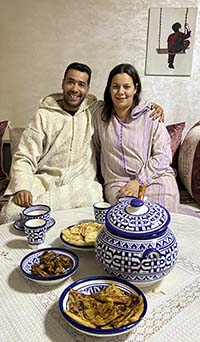
A Home-hosted meal with a couple living in Fez
The language is generally not a barrier to good conversation, because many Moroccans speak Arabic, French and English. Rick and I were hosted by a couple with two young sons who spent the evening outside playing with their friends. The father of the house is a cab driver; the mother is a police woman.
They are Muslim, but in my estimation very modern and progressive, and we spent the evening learning more about them. Not knowing much about Ramadan, I asked about the month-long observance and its nuances. Taking place in the ninth month of the Islamic calendar, it’s a month of fasting, prayer, reflection and community. It involves service to others, studying the Qur’an and cultivating self-control, gratitude and compassion for those less fortunate.
We had an amazing conversation that helped me learn more about Islam from devout Muslims and how it affects their everyday life.
The next day our group visited an important 3rd century BC archeological site near Fez, Volubilis UNESCO World Heritage Centre.
At 104 acres, remains of the Romans’ town include large Roman free-standing arches and parts of several buildings used by the government, the foundations of homes and businesses such as a bakery, a winery and an olive press, well-preserved mosaics and a long promenade lined with columns that still stand.
As we left Fez headed toward the desert, we stopped to meet a multigenerational nomad family. Abdu told us that the best gift we could bring was bagged sugar so he purchased about 20 pounds at a small store before we reached their homestead. The grandfather greeted us and led us to the bread bakery where the mother was cooking plain unleavened bread in an open stone oven fired with wood.
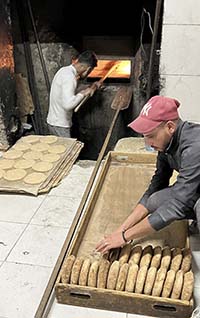
Bread, a staple for Moroccans, is baked daily in community ovens in smaller towns to provide for smaller families.
Bread is a staple in Moroccan homes and it’s served with all three meals, including at restaurants. Our experience with this family would be replicated several other times as we visited with families on farms and people in small villages.
As the bread baked, the grandfather poured us Moroccan mint tea as a greeting of hospitality. Hot from the oven, the fresh bread was exquisite, tender and flavorful.
I visited with the grandfather inside their simple clay, straw and stick-built home. Blankets hung as doors and covered the floors. A separate kitchen was very basic. Sleeping rooms had thin palettes as beds.
A covered tent nearby gave shelter from the sun as the mother wove woolen blankets on a simple loom. A pen for a few goats kept them within sight and safe from predators.
As we continued on our journey, they smiled and waved goodbye, seemingly happy with the life they live. There were no radios, newspapers or televisions to communicate the state of the world. They had food, shelter and family, all supporting each other, something that we would see again as we crossed the High Atlas Mountains into the Sahara Desert.
Next time: Sleeping in the desert, learning about innovative ways to access water, visiting Africa’s second-largest Mosque and finding out what’s it really like in Marrakech and Casablanca.
Photos: by Pamela A. Keene. For additional photos, see next month’s video that includes part 1 and part 2 of Morocco.


